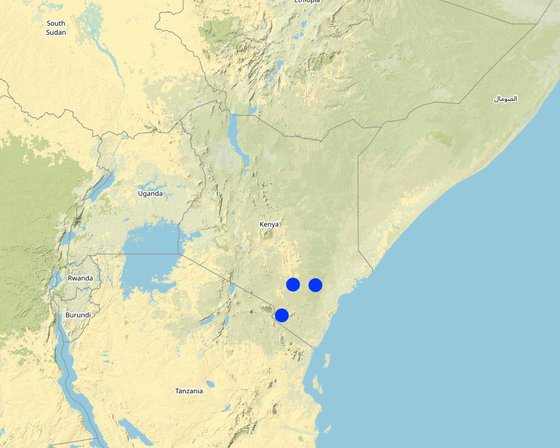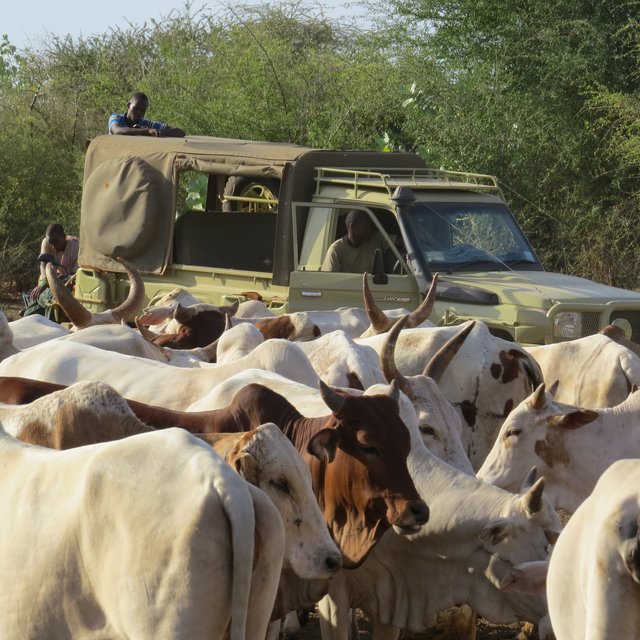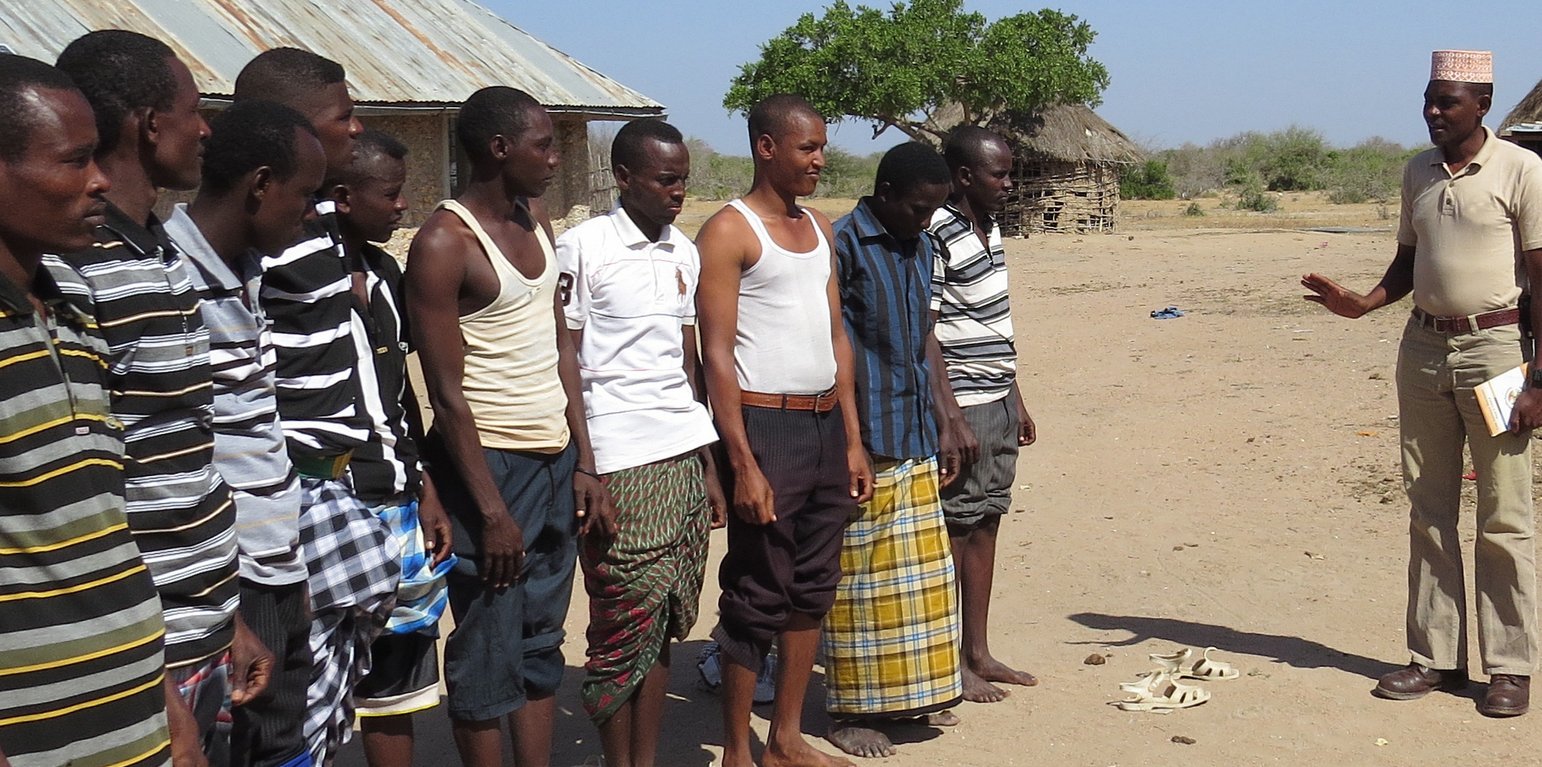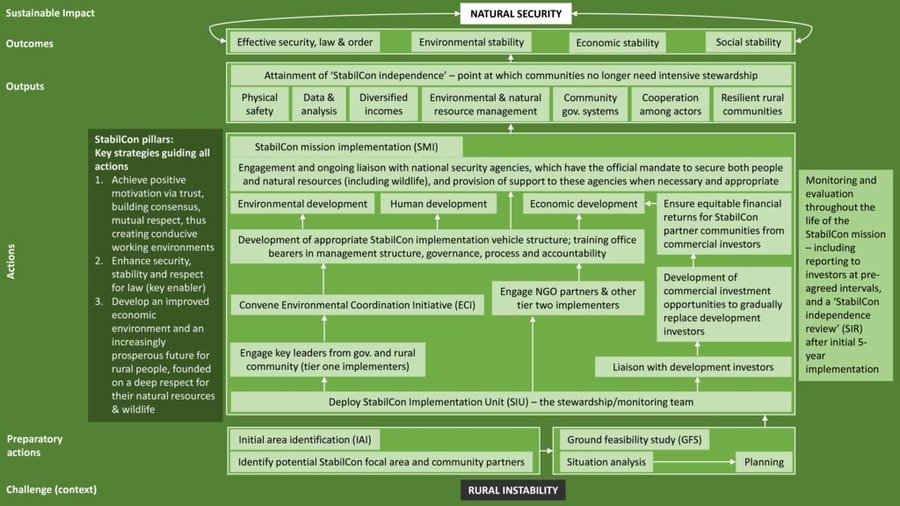Stabilization Through Conservation ('StabilCon') approach
(Kenya)
Description
The 'StabilCon' approach is a non-aggressive, low-intensity stabilization model that seeks to reconcile the needs of both humans and their natural environment. To achieve this, StabilCon aims to co-develop two mutually beneficial elements: sustainable natural resource management and human security in rural areas.
StabilCon is a holistic approach that seeks to develop social-ecosystems that accept wildlife and respect natural resources, in order to address complex conservation challenges. Implemented by rural communities, in partnership with local stewardship organizations, such as Tsavo Conservation Group, StabilCon aims to build human and natural resource security. StabilCon also aims to shift the human-wildlife relationship from conflict towards a symbiotic relationship with mutual benefits. The approach is based on the premise that unstable environments (whether due to human, economic or environmental factors) preclude any conservation, sustainable development or natural resource management initiative. Therefore, StabilCon seeks to build institutional capacity in rural communities to achieve four interrelated goals: 1) Support the rule of law (e.g. through training of community rangers) to reduce physical insecurity for humans, wildlife and natural resources to manageable levels as a mandatory first step; 2) Use this security as a foundation on which to build and diversify nature-based economic opportunities (e.g. reduced wildlife poaching facilitates the development of tourism-based economic opportunities, while greater local security can also benefit livestock-keeping by reducing the incidents of stock thefts); 3) Strengthen environmental security to enable benefits of biodiversity conservation and healthy ecosystems to be shared by current and future generations; 4) Develop more robust, equitable and representative community governance system, aligned with county and national government agencies and their objectives (e.g. through governance training within rural communities).
StabilCon aims to use these four interrelated goals to develop a foundation of long-term environmental security and create circumstances conducive to socio-economic progress of rural communities. Activities are conducted by the StabilCon Implementation Unit (SIU), which in the Tsavo Model is composed of 5 members: 1) CEO & co-founder of Tsavo Conservation Group (TsavoCon) - responsibilities include managing TsavoCon's strategic direction through StabilCon, developing & managing strategic relationships, working with Kenya's national and county governments and US government, international fund raising; 2) TsavoCon Chief Financial Officer - Taita Taveta born and a member of the Association of Chartered Accountants (London) who leads human resources issues and is responsible for financial operations (e.g. opening bank accounts for full time staff, introducing and managing accounting software); 3) Operations Officer - supports CEO in developing strategic relationships (e.g. liaison with Taita Conservancy elders, county government officials, NGO partners) and is a Geographic Information System analyst developing a map database (e.g. elephant poaching data); 4) Liaison Officer - responsible for engagement with Orma community members of Malkahalaku Community Conservancy as well as liaison with local and national government officials, and to manage the conservancy's rangers (he was formerly an instructor with the Kenya Wildlife Service); 5) TsavoCon Pilot - responsibilities include managing aerial observation operations, TsavoCon vehicles, communications, resupply & logistics of TsavoCon assets in the field.
Lieu

Lieu: Greater Tsavo Ecosystem, Kenya
Géo-référence des sites sélectionnés
-
37.9643, -3.39734
-
38.41748, -2.18756
-
39.29237, -2.22786
Date de démarrage: 2016
Année de fin de l'Approche: sans objet
Type d'Approche
-
traditionnel/ autochtone
-
initiative/ innovation récente locale
-
fondé sur un projet/ programme

Malkahalaku Community Conservancy rangers on patrol. (Tanya Saunders)
Objectifs de l'approche et environnement favorable
Principaux objectifs de l'Approche
StabilCon seeks to build institutional capacity in rural communities to achieve four interrelated goals:
1) Effective security, law and order - Support the rule of law to reduce physical insecurity for humans, wildlife and natural resources to manageable levels as a mandatory first step to enable the other three goals;
2) Economic security - Use this security as a foundation on which to build and diversify nature-based economic opportunities (e.g. livestock and tourism);
3) Environmental security - Strengthen environmental security to enable benefits of biodiversity conservation and healthy ecosystems to be shared by current and future generations;
4) Social security - Develop more robust, equitable and representative community governance system, aligned with county and national government agencies and their objectives.
Conditions favorisant la mise en oeuvre de la/(des) Technologie(s) appliquée(s) sous l'Approche
-
Normes et valeurs sociales/ culturelles/ religieuses : Livestock, water and security are already top priorities for local communities and are in alignment with StabilCon's objectives.
-
Disponibilité/ accès aux ressources et services financiers: USAID and other donors assist greatly by funding StabilCon's activities.
-
Collaboration/ coordination des acteurs: The improved relationship between the Malkahalaku community and the Kenya Wildlife Service (national government), facilitated by StabilCon's Implementation Unit (SIU), has been beneficial particularly in conflict mitigation.
-
Cadre juridique (régime foncier, droits d'utilisation des terres et de l'eau): The official conservancy status given when the Malkahalaku Community Conservancy was established in 2015 was crucial in providing land tenure security. This stronger land tenure security has been instrumental in NRM through resolving conflicts with neighbouring communities over access to grazing/water.
-
Cadre politique: The Wildlife Act has been particularly beneficial through its support of conservation activities. The Act emphasises effective public participation in the management of wildlife resources, thereby setting a basis for the strengthening of community based NRM.
-
Connaissances sur la GDT, accès aux supports techniques: StabilCon aims to integrate the extensive local knowledge relating to pastoralism among Oromo people. However, traditional livestock management practices are also evolving and the Oromo are moving towards reducing livestock numbers and raising livestock quality (similar to the ranching approach).
Conditions entravant la mise en oeuvre de la/(des) Technologie(s) appliquée(s) sous l'Approche
-
Normes et valeurs sociales/ culturelles/ religieuses : Rural communities, limited in their access to education, find it difficult to navigate the bureaucratic processes involved in securing funding.
-
Collaboration/ coordination des acteurs: Dysfunctional relationships among local chiefs and between Malkahalau community and the Kenya Wildlife Service (KWS) were initially hindering. In addition, almost every year, heightened competition over fodder/water for livestock between pastoralists and agriculturalists and between neighbouring pastoral communities lead to conflicts, which are often violent. Previously, the dysfunctional relationship between Malkahalaku community and KWS led to confrontations and destruction of KWS infrastructure. On one occasion, KWS rangers posted in the community were chased out by community members and the KWS ranger post burnt down by community members.
-
Gouvernance foncière (prise de décisions, mise en œuvre et application des décisions): Poor law enforcement in rural areas leads to social insecurity at the community level. This impacts many aspects of NRM including illegal wildlife poaching and armed conflicts between pastoralist groups over access to grazing/water.
-
Connaissances sur la GDT, accès aux supports techniques: Some previous local pastoral practices are no longer applicable to the changing environment, particularly with regard to quality and number of livestock, but practices are changing. For example, the shift from emphasis on the number of livestock owned towards smaller herd sizes and higher quality livestock.
-
Marchés (pour acheter les intrants, vendre les produits) et prix: Importing meat from neighbouring countries (e.g. Tanzania, Uganda) floods Kenya's market, leading to a poor economic environment for local livestock production. StabilCon is currently planning to improve Malkahalaku Community Conservancy's access to national beef markets that will provide more favourable prices for the community's members.
-
Charge de travail, disponibilité de la main-d'œuvre: StabilCon has a small team, but their dedication helps compensate for the limited man hours.
-
Autre: Social insecurity is one of the main barriers and it is exacerbated by climatic changes. More specifically, shifts in patterns and temporal distribution of rainfall pose challenges even for highly mobile pastoralists. During drought periods, heightened competition over grazing and water intensify human conflict. These conflicts over basic resources preclude NRM activities.
Participation et rôles des parties prenantes impliquées dans l'Approche
Parties prenantes impliquées dans l'Approche et rôles
| Quels acteurs/ organismes d'exécution ont été impliqués dans l'Approche? |
Spécifiez les parties prenantes |
Décrivez le rôle des parties prenantes |
| exploitants locaux des terres / communautés locales |
Taita Taveta Wildlife Conservancies Association and Malkahalaku Community Conservancy. |
In the Taita area, Taita Taveta Wildlife Conservancies Association is the main local institutional actor, as it represents all 28 conservancies in the area (a large number of community members sign up to be part of one or more conservancies). In the Tana River County area, Malkahalaku Community Conservancy is the main institutional actor. |
| Spécialistes de la GDT/ conseillers agricoles |
Tsavo Conservation Group (TsavoCon). TsavoCon is composed of four members: CEO (an experienced protected area manager and leader of international relations; degree in Wildlife Conservation Management), Tana River County Coordinator (paramilitary-trained with experienced in wildlife conservation/anti-poaching; diploma in Wildlife Sanctuary Management), Taita Taveta County Coordinator (experienced wildlife conservationist and former CEO of Taita Taveta Wildlife Conservancies), Chief Financial Officer (experienced in conservation-focused non-profit management). |
In the Tsavo Model of StabilCon, TsavoCon is the main facilitating organization, providing a link between local communities, livestock and rangeland management experts and international funding organisations. TsavoCon acts as the StabilCon Implementation Unit (SIU) in the Greater Tsavo Ecosystem. |
| chercheurs |
Geographic Information System specialist. |
This researcher compiles data collected by StabilCon on poaching and insecurity. Tracking trends in elephant poaching as an indicator of increased security is one of the ways in which these data are used. |
| ONG |
Global Environmental Facility, African Wildlife Foundation, Wildlife Works. |
These NGO's fund StabilCon's activities and/or act as conservation partners of Tsavo Conservation Group. |
| gouvernement local |
These include: the county environmental minister and their department; the county minister of lands; the county minister of livestock; the chairman of conservation compensation committee. |
These actors are involved in allocation of local government support for community-level projects. |
| gouvernement national (planificateurs, décideurs) |
Kenya Wildlife Service (KWS), County Security Committee (national security apparatus) |
These actors are mandated national security agencies. KWS's Law Enforcement Academy trained 22 members of Malkahalaku Community Conservancy (funded by Tsavo Conservation Group), who are now rangers for the conservancy. These rangers patrol their conservancy, increasing human security and reducing poaching. During droughts, KWS allow Malkahalaku Community Conservancy livestock to graze in Tsavo East National Park to relieve pressure on the community and diffuse conflicts over fodder/water. In Kenya, this is a relatively common but controversial practice as it puts pressure on the land within the protected area and potentially increases herd sizes and overall grazing pressure, particularly over the long term. |
| organisation internationale |
USAID, Global Environment Facility, African Wildlife Foundation, Wildlife Works |
Funding and/or Tsavo Conservation Group conservation partners. |
Organisme chef de file
In the Tsavo model of StabilCon, Tsavo Conservation Group fulfils the role of StabilCon Implementation Unit (SIU), and is the lead facilitator and coordinator in the Greater Tsavo Ecosystem.
Participation des exploitants locaux des terres/ communautés locales aux différentes phases de l'Approche
aucun
passive
soutien extérieur
interactive
auto-mobilisation
initiation/ motivation
Under the StabilCon approach, international and local actors are involved in the initiation phase but it leads towards self mobilization.
planification
The StabilCon Implementation Unit (composed of a coordinator, experts/professionals and local actors) leads the planning phase, which includes an area identification and a ground feasibility study.
mise en œuvre
All activities are implemented by local communities.
suivi/ évaluation
Data is mainly collected and analyzed by specialists/experts.
Diagramme/ organigramme
Conceptual model of StabilCon approach and Theory of Change.
Prises de décision pour la sélection de la Technologie de GDT
Les décisions ont été prises par
-
les exploitants des terres seuls (auto-initiative)
-
principalement les exploitants des terres soutenus par des spécialistes de la GDT
-
tous les acteurs concernés dans le cadre d'une approche participative
-
principalement les spécialistes de la GDT, après consultation des exploitants des terres
-
les spécialistes de la GDT seuls
-
les responsables politiques/ dirigeants
Les décisions ont été prises sur la base de
-
l'évaluation de connaissances bien documentées en matière de GDT (prises de décision fondées sur des preuves tangibles)?
-
les résultats de recherches?
-
expériences et opinions personnelles (non documentées)
Soutien technique, renforcement des capacités et gestion des connaissances
Les activités ou services suivants ont fait partie de l'approche
-
Renforcement des capacités/ formation
-
Service de conseils
-
Renforcement des institutions (développement organisationnel)
-
Suivi et évaluation
-
Recherche
Renforcement des capacités/ formation
La formation a été dispensée aux parties prenantes suivantes
-
exploitants des terres
-
personnels/ conseillers de terrain
-
local government (e.g. accounting, legal, economic)
Formats de la formation
-
sur le tas
-
entre agriculteurs (d'exploitants à exploitants)
-
zones de démonstration
-
réunions publiques
-
cours
Sujets abordés
22 members of the Malkahalaku Community Conservancy were trained through a Kenya Wildlife Service Law Enforcement Academy programme, to enable them to serve as rangers for their conservancy to improve local security. The StabilCon implementation Unit also conducted courses to train the Conservancy's management and employees in various offices (e.g. accounting, legal, economic) to improve governance in Malkahalaku Community Conservancy.
Service de conseils
Le service de conseils était fourni
-
dans les champs des exploitants?
-
dans des centres permanents
-
Depends on who is receiving the advice.
StabilCon Implementation Unit (SIU) provides advice to individuals at multiple levels from government to local.
Renforcement des institutions
Institutions ont été renforcées ou mises en place
-
non
-
oui, un peu
-
oui, modérément
-
oui, beaucoup
Décrivez l'institution, ses rôles et responsabilités, ses membres, etc.
Tsavo Conservation Group, as the StabilCon Implementation Unit (SIU), liaise with all stakeholders to develop an integrated landscape security model in Taita
Type de soutien
-
financier
-
renforcement des capacités/ formation
-
équipement
Plus de détails
The Kenya Wildlife Service is due to train 40 Taita community rangers at their Law Enforcement Academy, funded by USAID in conjunction with Tsavo Conservation Group.
Financement et soutien matériel externe
Budget annuel en dollars US de la composante GDT
-
< 2 000
-
2 000-10 000
-
10 000-100 000
-
100 000-1 000 000
-
> 1 000 000
Precise annual budget: sans objet
USAID and private donors are the main funding sources.
Les services ou mesures incitatives suivantes ont été fournis aux exploitants des terres
-
Soutiens financiers/ matériels fournis aux exploitants des terres
-
Subventions pour des intrants spécifiques
-
Crédits
-
Autres incitations ou instruments
Soutiens financiers/ matériels fournis aux exploitants des terres
Tsavo Conservation Group raises external funding for rangers (training, salaries etc.), security infrastructure (buildings, vehicles etc.); logistics, planning and deployment costs. However, the StabilCon approach aims to make all activities economically self-sustaining through internal funding.
Analyses d'impact et conclusions
Impacts de l'Approche
Non
Oui, un peu
Oui, modérément
Oui, beaucoup
Est-ce que l'Approche a autonomisé les exploitants locaux des terres, amélioré la participation des parties prenantes?
The training of community conservancy rangers enables the conservancies to increase the degree to which they manage their own security, and are less dependent on already overstretched government law enforcement agencies.
Est-ce que l'Approche a aidé les exploitants des terres à mettre en œuvre et entretenir les Technologies de GDT?
Data collected thus far indicates that elephant poaching has declined considerably since StabilCon's implementation, but it is not yet possible to gauge the sustainability due to the short duration of operation.
Est-ce que l'Approche a amélioré la coordination et la mise en œuvre de la GDT selon un bon rapport coût-efficacité?
By acting as an impartial arbitrator, the StabilCon Implementation Unit facilitated coordination between chiefs who previously had dysfunctional relationships.
Est-ce que l'Approche a mobilisé/ amélioré l'accès aux ressources financières pour la mise en œuvre de la GDT?
StabilCon raised funding from international organizations such as USAID, that would otherwise have been inaccessible to local people.
Est-ce que l'Approche a amélioré les connaissances et les capacités des autres parties prenantes?
Capacity building was provided to local government employees (e.g. accountants, legal, economic). It was also provided to conservancy members in the form of ranger training.
Est-ce que l'Approche a construit/ renforcé les institutions, la collaboration entre parties prenantes?
StabilCon facilitated collaboration among actors who previously did not coordinate at local-level (chiefs) and government-level (government departments).
Est-ce que l'Approche a atténué les conflits?
The StabilCon Implementation Unit helped mitigate conflicts between Malkahalaku Community members and the Kenya Wildlife Service (national government) by facilitating dialogue and acting as third party mediators.
Est-ce que l'Approche a conduit à l'utilisation/ sources d'énergie plus durables?
No energy source dimension to the approach.
Est-ce que l'Approche a amélioré la capacité des exploitants des terres à s'adapter aux changements/ extrêmes climatiques et a atténué les catastrophes liées au climat?
As StabilCon has only been active for 3 years this is difficult to judge.
Est-ce que l'Approche a conduit à des emplois, des opportunités de revenus?
StabilCon created job opportunities relating to conservancy security (mainly rangers).
Principale motivation des exploitants des terres pour mettre en oeuvre la GDT
-
augmenter la production
-
augmenter la rentabilité/ bénéfice, rapport coûts-bénéfices
-
réduire la dégradation des terres
-
réduire les risques de catastrophe
-
réduire la charge de travail
-
paiements/ subventions
-
règles et règlements (amendes)/ application
-
prestige, pression sociale/ cohésion sociale
-
affiliation à un mouvement/ projet/ groupe/ réseaux
-
conscience environnementale
-
coutumes et croyances, morale
-
améliorer les connaissances et compétences en GDT
-
améliorer l'esthétique
-
atténuer les conflits
Durabilité des activités de l'Approche
Les exploitants des terres peuvent-ils poursuivre ce qui a été mis en oeuvre par le biais de l'Approche (sans soutien extérieur) ?
Conclusions et enseignements tirés
Points forts: point de vue de l'exploitant des terres
-
Due to StabilCon's structured approach, it can be budgeted in the long term.
-
StabilCon requires minimal intervention and relies mainly on internal motivation and activity.
-
The long-term aim is for revenue to be generated internally and sustainably through a structured investment model.
Points forts: point de vue du compilateur ou d'une autre personne-ressource clé
-
Enables local communities to access international funds.
-
The StabilCon approach seeks to leverage the interaction between SLM and human security.
-
Integration of international SLM experience with local knowledge.
-
The StabilCon approach seeks to identify the extraordinary in people and nurture their strengths
Faiblesses/ inconvénients/ risques: point de vue de l'exploitant des terrescomment surmonter
-
The need to raise start-up funding.
Ensure adequate focus on fund-raising.
-
StabilCon is not a stand-alone 'silver bullet', but needs a certain amount of national infrastructure in place in order to operate.
None.
-
StabilCon depends heavily on the individuals employed and can thus be impacted considerably by the human weaknesses of individuals.
Over the long-term, educate people to develop interdisciplinary skills.
Faiblesses/ inconvénients/ risques: point de vue du compilateur ou d'une autre personne-ressource clécomment surmonter
-
With few years of active experience of StabilCon, the benefits, downfalls and sustainability of the approach are still unclear.
Continuation of the approach will reveal its strengths and weaknesses.
Références
Examinateur
-
Donia Mühlematter
-
Hanspeter Liniger
-
Rima Mekdaschi Studer
-
Joana Eichenberger
Date de mise en oeuvre: 6 avril 2018
Dernière mise à jour: 2 novembre 2021
Description complète dans la base de données WOCAT
Données de GDT correspondantes
La documentation a été facilitée par
Institution
Projet
- Book project: Guidelines to Rangeland Management in Sub-Saharan Africa (Rangeland Management)
Références clés
-
Saunders I, Saunders T (2017) The StabilCon Brief: Freely available an in the public domain
Liens vers des informations pertinentes disponibles en ligne
- Stabilization Through Conservation (StabilCon) on Tsavo Conservation Group website: http://www.tsavocon.org/stabilcon/
- Tsavo Conservation Group's eMAP (Elephant Monitoring and Anti-Poaching) project: None






